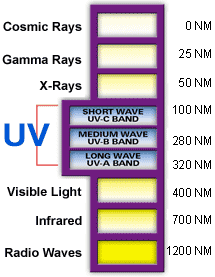 |
UV Air And Water Purification | |
| Contact | Login | ||
| profile | uv systems | uv science facts | press releases | uv info | business programs |
The Germicidal Nature Of UV Light
|
|
|
Ultraviolet rays have shorter wavelengths than visible light. A wavelength,
the distance between the crests of two waves, is often measured in units called
nanometers. A nanometer (nm) is a billionth of a meter, or about 1/25,000,000
inch. Wavelengths of visible light range from about 400 to 700 nm. Ultraviolet
wavelengths range from about 1 to 400 nm and are beyond the range of visible
light.
Ultraviolet rays with wavelengths shorter than 300 nm are extremely effective in
killing microorganisms. The most effective sterilizing range for UV is within
the C bandwidth (UVC). This range is called the germicidal bandwidth. UVC has
been used in hospitals for decades to sterilize surgical instruments, water, and
the air in operating rooms. Many food and drug companies use germicidal lamps to
disinfect various types of products and their containers.
UV disinfects through a photochemical process. The contaminants that
pollute the indoor environment are almost entirely based upon organic or
carbon-based compounds. These compounds breakdown when exposed to high intensity
UV at 240 to 280 nm. Short-wave ultraviolet light can destroy DNA in living
microorganisms and breakdown organic material found in indoor air. UVC’s
effectiveness is directly related to intensity and exposure time.
UV rays must strike the contaminants directly in order to penetrate the
microorganism and breakdown its molecular bonds. This bond breakage translates
into cellular or genetic damage with the germs rendered harmless by robbing them
of the ability to reproduce.
UV Fact Sheet
About Ultraviolet (UV) Light Used for Air Disinfection
by Edward A. Nardell, M. D. Harvard Medical School
What is UV or ultraviolet light? Ultraviolet light is part of the spectrum of electromagnetic energy generated by the sun. The full spectrum includes, in order increasing energy, radio waves, infrared, visible light, ultraviolet, x-rays, gamma rays and cosmic rays. Since UV is not visible, it is technically not "light", but use of the term "ultraviolet light" is so widespread that, it will be used here. Most sources of light generate some UV. For air disinfection, UV is generated by electric lamps that resemble ordinary fluorescent lamps.
What is germicidal UV? This is UV of a specific type (253.7nm wavelength) known to kill airborne germs that transmit some infections from person to person within buildings. Germicidal UV is aimed at the upper room air so that only airborne microbes are directly exposed. Room occupants are exposed only to low levels of reflected UV - levels below that known to cause eye irritation. Germicidal UV has been used safely and effectively in hospitals, clinics and laboratories for more than 60 years. UV does not prevent transmission of infections (e.g. colds) by direct person to person contact.
Is UV harmful? We are all exposed to the UV in sunlight. UV exposure can be very harmful, or harmless, depending on the type of UV, the type of exposure, the duration of exposure, and individual differences in response to UV. There are three types of UV:
UV-A - Longwave UV, also known as "blacklight", the major type of UV in sunlight, responsible for skin tanning, generally not harmful, used in medicine to treat certain skin disorders.
UV-B - A small, but dangerous part of sunlight. Most solar UV-B is absorbed by the diminishing atmospheric ozone layer. Prolonged exposure is responsible for some type of skin cancer, skin aging, and cataracts (clouding of the lens of the eye).
UV-C - Also known as "shortwave" UV, includes germicidal (253.7nm wavelength) UV used for air disinfection. Unintentional overexposure causes transient redness and eye irritation, but does NOT cause skin cancer or cataracts.

© 2002 - 2017
American Air & Water®, Inc.
843-306-0070
Privacy Statement and other Policies
profile | uv systems | uv science facts | press releases | links and q&a | business programscontact | login